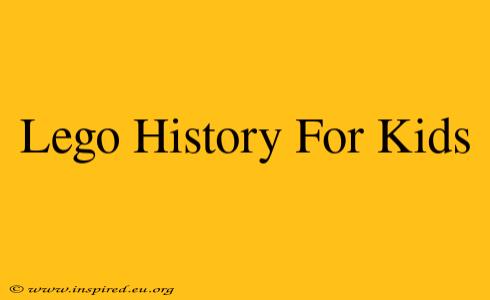Introduction
Ever wondered about the amazing history behind those colorful bricks you love to build with? Let's dive into the fascinating story of LEGOs – from humble beginnings to the global phenomenon they are today! LEGOs are more than just toys; they're a creative outlet that has sparked imaginations for generations. This article will explore the history of LEGOs, showing how they evolved from simple wooden toys into the incredibly versatile building blocks we know and love.
The Early Years: Wooden Toys and the Birth of LEGO
Early LEGO (1930s)
The LEGO story starts in Billund, Denmark, in 1932. Ole Kirk Christiansen, a carpenter, began making wooden toys in his small workshop. "LEGO" is actually a combination of the two Danish words, "leg" and "godt," meaning "play well." It wasn't until later that the name perfectly captured the spirit of the company's products.
The Plastic Revolution (1940s-1950s)
Plastic changed everything. In the late 1940s, Ole's son, Godtfred Kirk Christiansen, experimented with plastic bricks. These early plastic LEGO bricks weren't quite the same as the ones you know today. They were larger and didn't connect as easily. But this was a crucial step in making LEGOs more durable and affordable. By the 1950s, the company was focused on perfecting their plastic bricks, experimenting with different sizes and designs.
The LEGO Brick We Know and Love (1958 and Beyond)
The Automatic Binding System (1958)
The year 1958 was a game-changer! Godtfred developed the now-famous LEGO system of "automatic binding," meaning the bricks could connect securely and easily. This simple yet ingenious design is what made LEGOs truly special. This innovation was key to the LEGO's global success and is still used today. This revolutionary design allowed for countless construction possibilities, inspiring creativity worldwide.
LEGOs Go Global (1960s-1970s)
LEGO bricks started to become popular worldwide. They started expanding internationally, selling in other countries. New colors, shapes, and themes were introduced. This period saw the birth of iconic LEGO sets, laying the foundation for the vast universe of LEGO products we see today. The company's commitment to quality and innovation continued to solidify its position as a global leader in the toy industry.
LEGO Themes and Licenses (1980s-Present)
The 1980s brought exciting themed LEGO sets like LEGO Castle, LEGO Space, and LEGO Technic. The addition of minifigures (those small, iconic LEGO people) added a whole new dimension to the LEGO experience. Since then, LEGO has collaborated with countless brands and franchises—from Star Wars and Harry Potter to Marvel and Disney—expanding the possibilities for creative building. The introduction of licensed themes further expanded LEGO's appeal to a wider audience.
LEGO's Continued Success
LEGO has continually evolved. The company stays innovative with new technologies and sets. They keep pushing the boundaries of creativity and construction. LEGO’s success is a testament to the enduring power of simple, yet ingenious, design. Millions of children and adults all over the world continue to build, create, and explore with LEGOs.
What Makes LEGOs So Special?
- Endless Possibilities: You can build virtually anything you can imagine!
- Durable Bricks: LEGOs are designed to last for generations.
- Creative Play: LEGOs encourage imagination and problem-solving skills.
- Collectible Sets: There are countless themed sets to collect and build.
Conclusion
From wooden toys to the global phenomenon they are today, the story of LEGOs is a testament to innovation, creativity, and the power of play. So, the next time you’re building with your LEGOs, remember the rich history and ingenuity behind these iconic bricks! They’re more than just toys; they are tools for creativity and imagination.
